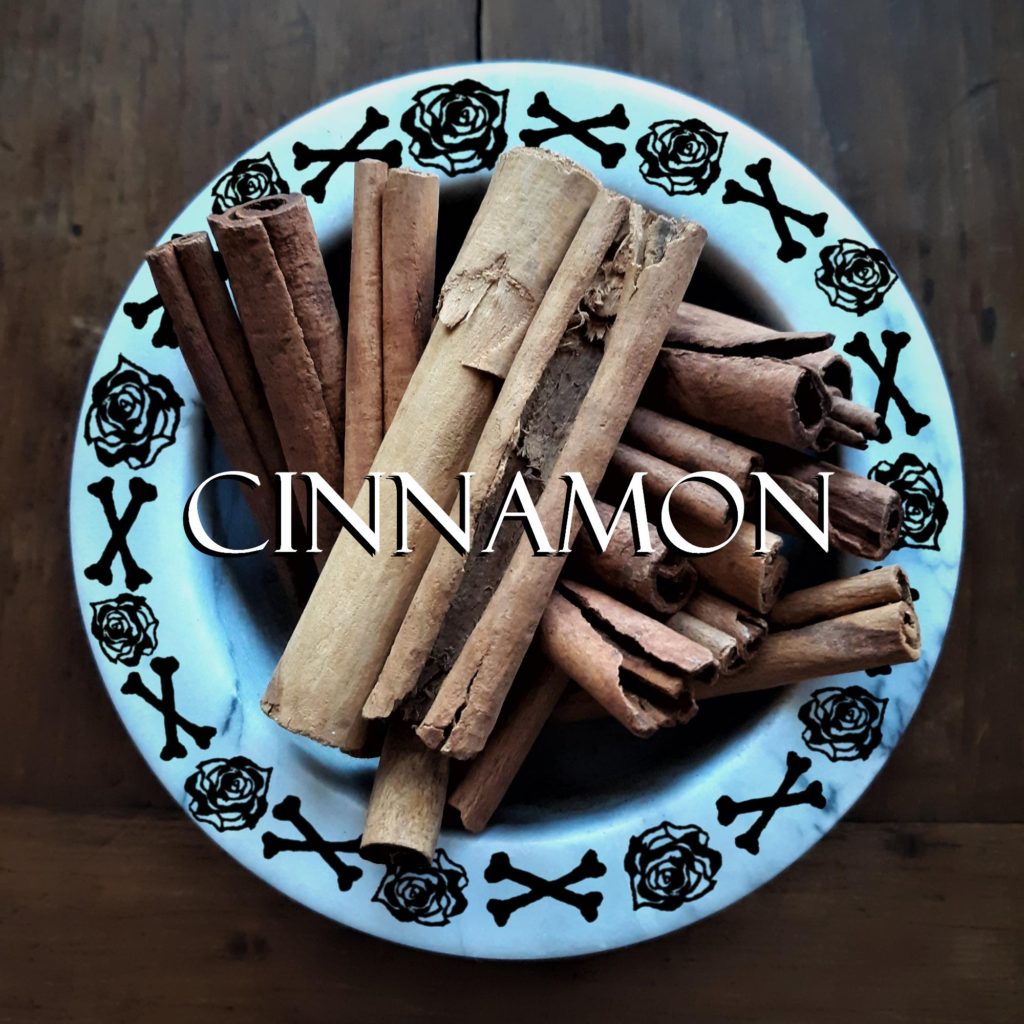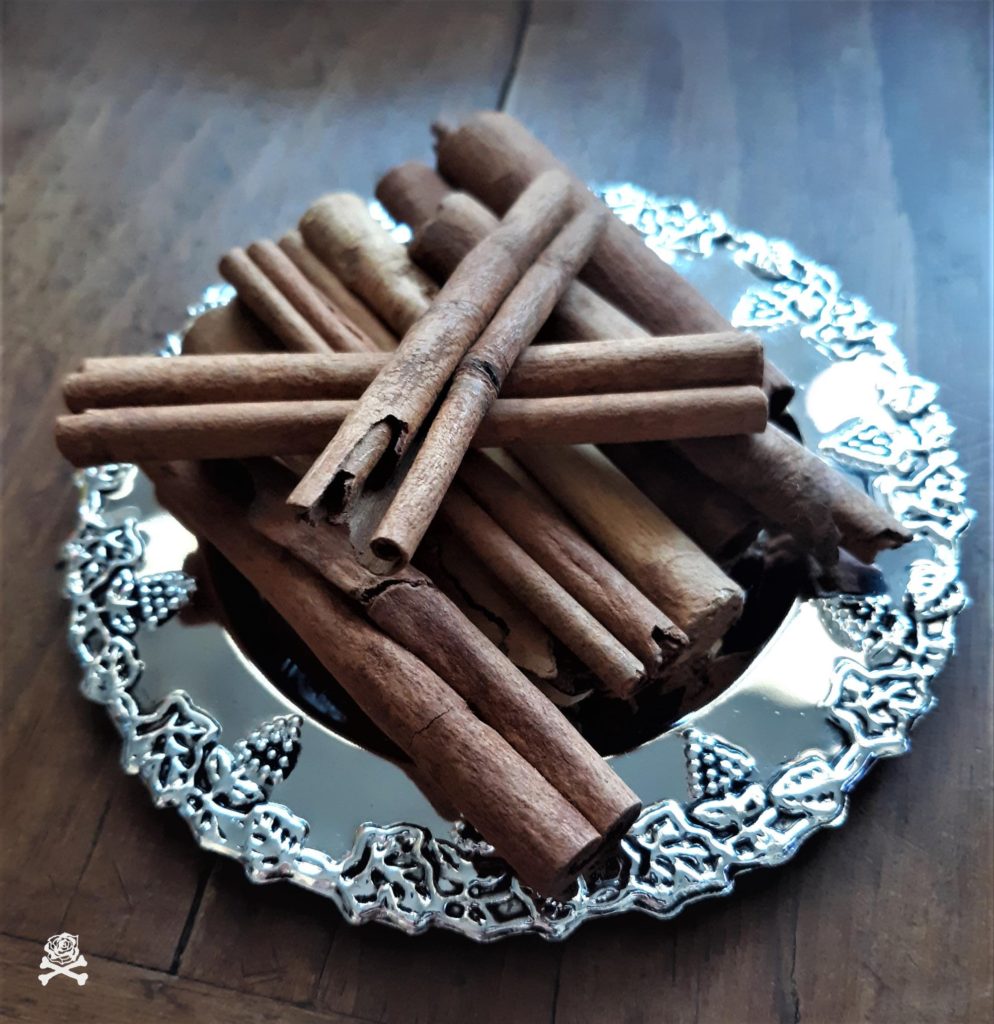
Cinnamon is a spice that has driven world travel and even war.
The spice trade was once quarrelsome and cinnamon once stood at the forefront of these ugly scrimmages.
This Th-HERBS-day, we honor Cinnamon (Cinnamomum cassia).
It’s an evergreen species part of the Laural (Lauraceae) family.
A notorious spice for holiday cooking, cinnamon is usually taken for granted because it is readily available in first-world countries.
In other countries, cinnamon is a cash crop, a way of life, and the heart of economic stability.
Native to Sri Lanka and Southern parts of India, farmers harvest and process cinnamon by hand.
In Ayurveda practices, cinnamon is one of the staples of holistic medicine.
In witchcraft, it is also a staple for winter solstice festivities, lust spells, and protection magic.
Cinnamon is ruled by the sun which makes it an adaptable herb in spell crafting.
It has an overall healing and protecting essence and complements any herbal mixture.
But…it can be less potent to your practice if this sun-ruled spice doesn’t get along with the planet-rulers of other paired herbs.
Be aware of the planets ruling the other herbs in your spells, because they may not vibe with cinnamon’s ruling Sun.

Cinnamon In History
The use of cinnamon dates to Egyptian times where it was used in mummification.
But the spice was barely known to European countries until around the 15th century.
Portuguese raiders of the time stumbled upon cinnamon throughout their years of raiding Arab ships.
This led to an increasing appetite for the spice and drove Portuguese explorers to sail the world to find its source.
After getting lost in rough seas, Portuguese sailors found themselves docked on cinnamon’s small native island, Sri Lanka.
Years after, many countries attempted to cease and exploit the island’s coveted spice.
Everyone wanted to rule the cinnamon trade, but the island’s people fiercely rebelled against these attempts.
Eventually, it was controlled by the British, and cinnamon became the economic focus of the island.
Today Sri Lanka is one of the few countries that produce the highest quality cinnamon called Ceylon cinnamon.
Growing this spice and harvesting it takes a long time and is tedious hard work.
The cinnamon comes from the inner bark of the tree and can only be extracted by carefully cutting into it.
The special skill involved in the trade is passed down from many generations of cinnamon farmers.
Unfortunately, newer generations are taking less interest in continuing the trade, and cinnamon production could become a rarity.
This may result in shortages and price increases on this adored dessert spice.
.
Cinnamon’s Medicinal Uses
You might associate cinnamon as a dessert ingredient more than a medicinal herb.
Surprisingly, it has a range of medicinal use and has been used for its healing abilities for a long time.
It is a strong antibacterial, antiviral and digestive aid.
Studies in Japan have found that cinnamon contains a compound that can kill fungal infections.
It was discovered to kill microorganisms that cause botulism and staph infection.
Cinnamon is also a wonderful stimulant and astringent.
The combination of all of these medicinal properties makes for a lovely scented skincare ingredient.
Try mixing rosehips, hibiscus, calendula, rose petals, and cinnamon with Epsom salts for a cleansing skin tightening bath soak.
Spell Crafting with Cinnamon
Cinnamon’s role as an inner protective layer of bark translates into spiritual workings.
The warming energy of its ruling Sun illuminates and stabilizes the power within your spells.
In witchcraft, cinnamon’s characteristics match the Sun’s adaptability while moving through the zodiac.
It can be protective, catalyzing, spiritually lifting, and attract both love and money.
It adds extra layers of stabilization and protection within the home and sparks passion in romance workings.
However, cinnamon can be stubborn if it doesn’t vibe with the other herbs in your magick.
When the planetary rulers of herbs don’t get along, it ignites more drama on your path than you’re prepared to deal with.
Think of it as the concept of “making a deal with the devil'” you may get what you asked for, but the consequences could be deceptive.
This is especially true for pairing Sun-ruled herbs like cinnamon, with Saturn-ruled herbs.
If you’re combining herbs with both the Sun and Saturn’s energy, careful planning is HIGHLY advised.
These two planets really don’t work nicely with one another and can result in attracting their tumultuous energy into your life.
But, when planned accordingly, the energy of these planets can be exceptionally powerful.
The battle between the sun and saturn
The Sun and Saturn have had beef with each other for a long time.
Both of these planets have fatherly characteristics and have so much in common that their egos clash hard.
Their energies will continuously fight for dominance, as they both really like to be in control and take the lead.
This could prolong your spell’s work and create obstacles that can result in abundance with unwanted added drama.
Nevertheless, the Sun will compromise with “enemy” planets when it has entered the enemy planet’s sign.
For instance, comfrey is a powerful money drawing herb and cinnamon can amplify success in money spells.
However, comfrey is ruled by Saturn and bumps heads with cinnamon’s fiery sun energy.
This could result in manifesting money with stressful consequences or money attached to problematic people.
Similar to what cinnamon attracted to Sri Lanka before problematic Europeans eventually led to its economic growth in the world trade
The Sun and Saturn will stubbornly fight for dominance unless the Sun has entered the Saturn-ruled sign of Capricorn.
Both Saturn and the Sun were simultaneously worshipped around the Yule Sabbat, particularly during Rome’s Saturnalia celebration.
These two planets have bumped heads over the spotlight as the “abundant providing father” for millennia.
But you can get them to work together smoothly when the Sun has entered Saturn-ruled Capricorn.
Pairing Saturn-ruled herbs with cinnamon for abundance is especially powerful during Capricorn season-especially on December 22nd, 23rd, and 24th.
These specific dates are when the Sun and Saturn are more understanding of each other and share roles as providers.
Abundance and protection crafting is exceptionally powerful on these dates.
Cinnamon’s Energetic Properties
The properties of cinnamon are an extremely helpful guide to assist you in spell crafting and rituals.
The energy of the herb is heightened when planned carefully with corresponding days, seasons, zodiacs, etc.
Here are 18 energetic properties associated with cinnamon:
1. Planet: Sun
2. Zodiac Sign: Leo
3. House: 5th
4. Element: Fire
5. Gender Energy: Masculine
6. Chakra: Ajna/Third Eye (Indigo)
7. Archangel: Raphael
8. Deity: Helios, Aphrodite (Greek), Baldur (Norse), Usil (Etruscan)
9. Sabbat: Lughnasadh, Yule
10. Season: Summer, Winter
11. Day: Sunday
12. Body: Sides, Back, Heart, The Right Eye of Males, The Left Eye of Females
13. Rune: Hagalaz, Nauthiz
14. Numerology: 1
15. Fae: Salamander
16. Major Arcana: The Sun, Strength
17. Minor Arcana: Wands
18. Cartomancy: Diamonds
Witch Herbs, Eco-friendly, Altar Herbs,

Cultivating and Storing Cinnamon
Cinnamon can be very tricky to grow and maintain if you don’t live in a warm and dry climate.
This dry evergreen tree thrives in zones 8 through 11 and needs dry soil to survive.
Regardless, some people have successfully grown cinnamon indoors outside its preferred zones.
If you use acidic soil, and it has adequate sunlight, it should do well in a roomy well-drained pot.
Be sure to provide plenty of nutrients to the soil because cinnamon can grow fast for a tree.
You can propagate by cuttings or from the seed, just make sure to plant in a hotbed in early spring.
Harvesting and Storing Cinnamon
You can harvest cinnamon right off the tree after about two to three years.
To harvest, you will need some patience and a very sharp knife.
The cinnamon is just beneath the outer bark of the tree and it can be very tough to get to.
Try planning your harvest early in the morning when the bark is softer from the morning dew.
This will make cutting into the tree much easier.
Using your knife or saw, peel off the outer layer of bark to expose the inner layer of bark.
This inner layer of bark is your cinnamon, which you will then peel away from the branch.
You’ll find that this inner bark is thin and generally comes off in sheets.
These sheets will need to be placed outside in a shaded area to dry (too much sun can dry out its tasty oils).
As the layers of bark dry, it will begin to curl in its famous cinnamon stick form.
To get more thorough direction on harvesting cinnamon, visit the wikiHow’s How to Grow Cinnamon article.
Happy Th-HERBS-day!
